
The Hepialidae are a family of insects in the lepidopteran order. Moths of this family are often referred to as swift moths or ghost moths.

Dumbletonius is a genus of moths of the family Hepialidae. There are two described species, both endemic to New Zealand.

Heloxycanus patricki, also known as the sphagnum porina moth, is a species of moth of the family Hepialidae, the ghost moths. It is the only member of the genus Heloxycanus. This species is endemic to New Zealand. It has been classified as having the status of "At Risk, Declining" by the Department of Conservation.
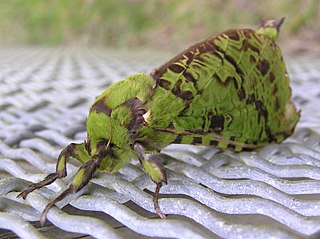
The pūriri moth, also commonly called the ghost moth or pepetuna, is a species of moth of the family Hepialidae. This moth is endemic to the North Island of New Zealand. It is New Zealand's largest moth, with a wingspan of up to 150 mm. It spends the first five to six years of its life as a grub in a tree trunk, with the last 48 hours of its life as a moth. Footage has been taken of a pūriri moth chrysalis hatching over a period of one hour and forty minutes.

Campbellana is a genus of moths of the Carposinidae family, containing only one species, Campbellana attenuata. This species is endemic to the Campbell Islands of New Zealand.
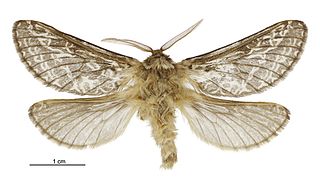
Aoraia aspina is a species of moth of the family Hepialidae. It was described by John S. Dugdale in 1994 from specimens collected in the Tasman, Otago and Southland districts. It is endemic to New Zealand.

Aoraia dinodes is a species of moth of the family Hepialidae. It is endemic to New Zealand. This moth was described by Edward Meyrick in 1890 from specimens collected in Invercargill by Captain Hutton.

Aoraia enysii, also known as the forest ghost moth is a species of moth of the family Hepialidae. It is endemic to New Zealand. This is the only species of the genus Aoraia that can be found in the North as well as the South Island. This species can be found from Mount Te Aroha southwards. This species was described by Arthur Gardiner Butler in 1877 from a specimen obtained in the North Island by J. D. Enys.

Aoraia flavida is a species of moth from the family Hepialidae. It is endemic to New Zealand. This species was described by John S. Dugdale in 1994 from specimens obtained near Gem Lake in the Umbrella Mountains in Southland and collected by B. H. Patrick.
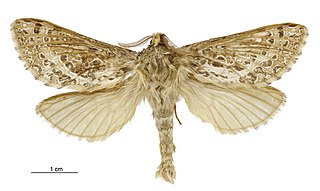
Aoraia insularis, also known as the Rakiura ghost moth, is a species of moth of the family Hepialidae. It is endemic to New Zealand and is found on only on Stewart Island and Steward Island's surrounding smaller islands. It was described by John S. Dugdale in 1994.

Aoraia macropis is a species of moth of the family Hepialidae. It is endemic to New Zealand and is found in the mountains of southern Central Otago. It was described by John S. Dugdale in 1994.

Aoraia senex is a species of moth of the family Hepialidae. It is endemic to New Zealand, where it is known from the South Island. This species was first described by George Vernon Hudson in 1908 from specimens discovered by J. H. Lewis in Central Otago.

Dioxycanus fusca is a species of moth of the family Hepialidae. It is endemic to New Zealand. This species was first described by Alfred Philpott in 1914 as Porina fusca using specimens collected by C. Fenwick and M. O. Pasco. In 1966 L. J. Dumbleton reviewed New Zealand Hepialinae and placed this species within the genus Dioxycanus, giving it the new combination Dioxycanus fuscus.

Dioxycanus oreas is a species of moth of the family Hepialidae. It is endemic to New Zealand. It was first described by George Vernon Hudson in 1920. The species was discovered by Averil Lysaght.

Dumbletonius characterifer is a species of moth of the family Hepialidae. It is endemic to New Zealand. It was first described by Francis Walker in 1865.

Wiseana copularis is a species of moth belonging to the family Hepialidae. It is endemic to New Zealand. This moth is one of several very similar looking species within the genus Wiseana and this group are collectively referred to as "Porina" moths. In its larvae form this species consumes pasture grasses and, if numerous, is regarded as a pest by New Zealand farmers reliant on good quality pasture for their stock.
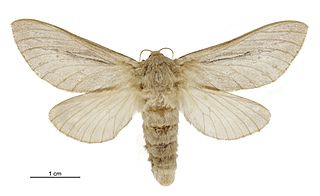
Wiseana umbraculata, also known as the bog porina, is a species of moth belonging to the family Hepialidae. There are seven endemic species and three haplotypes of Wiseana in New Zealand including bog porina. It was regarded as being common in Whanganui in the early twentieth century.
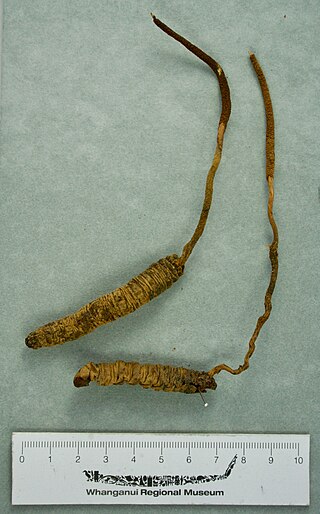
Ophiocordyceps robertsii, known in New Zealand as vegetable caterpillar is an entomopathogenic fungus belonging to the order Hypocreales (Ascomycota) in the family Ophiocordycipitaceae. It invades the caterpillars of leaf-litter dwelling moths and turns them into fungal mummies, sending up a fruiting spike above the forest floor to shed its spores. Caterpillars eat the spores whilst feeding on leaf litter to complete the fungal life cycle. Evidence of this fungus can be seen when small brown stems push through the forest floor: underneath will be the dried remains of the host caterpillar. This species was first thought by Europeans to be a worm or caterpillar that burrowed from the top of a tree to the roots, where it exited and then grew a shoot of the plant out of its head. It was the first fungus provided with a binomial name from New Zealand.

Hierodoris bilineata is a species of moth in the family Oecophoridae. It is endemic to New Zealand. This species is classified as "At Risk, Naturally Uncommon" by the Department of Conservation. It is possible that this species gives birth to live young rather than lay eggs as is the norm.

Lysiphragma argentaria is a species of moth in the family Tineidae. It is endemic to New Zealand. It is classified as "At Risk, Naturally Uncommon" by the Department of Conservation.






















